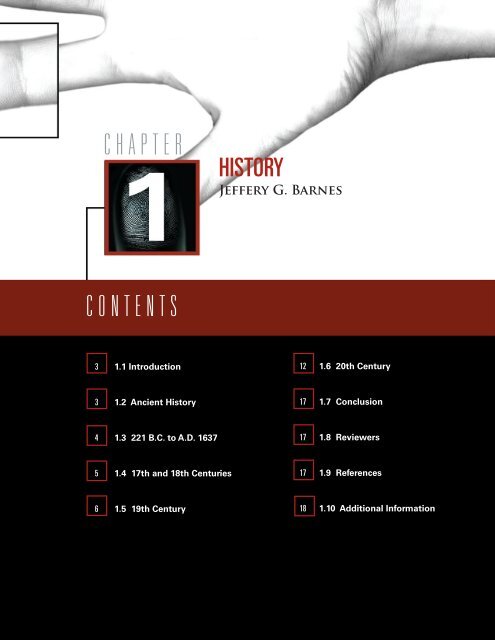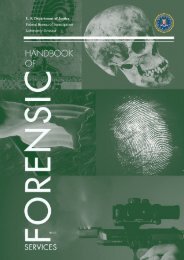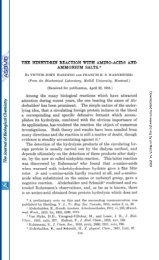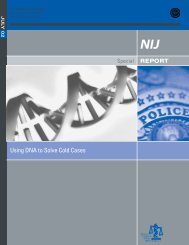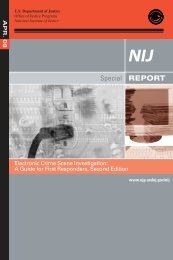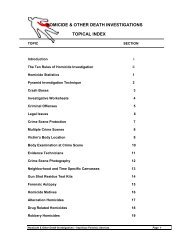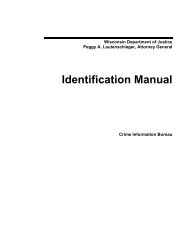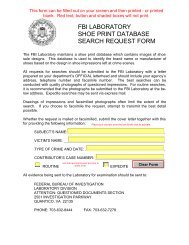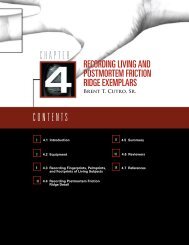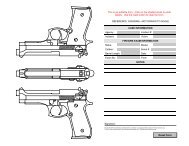Fingerprint Sourcebook Chapter 1 - Imprimus Forensic Services
Fingerprint Sourcebook Chapter 1 - Imprimus Forensic Services
Fingerprint Sourcebook Chapter 1 - Imprimus Forensic Services
Create successful ePaper yourself
Turn your PDF publications into a flip-book with our unique Google optimized e-Paper software.
<strong>Chapter</strong><br />
HISTORY<br />
Jeffery G. Barnes<br />
CONTENTS<br />
3 1.1 Introduction<br />
12 1.6 20th Century<br />
3 1.2 Ancient History<br />
17 1.7 Conclusion<br />
4 1.3 221 B.C. to A.D. 1637<br />
17 1.8 Reviewers<br />
5 1.4 17th and 18th Centuries<br />
17 1.9 References<br />
6 1.5 19th Century<br />
18 1.10 Additional Information
History <strong>Chapter</strong> 1<br />
<strong>Chapter</strong> 1<br />
History<br />
Jeffery G. Barnes<br />
1.1 Introduction<br />
The long story of that inescapable mark of identity has<br />
been told and retold for many years and in many ways. On<br />
the palm side of each person’s hands and on the soles of<br />
each person’s feet are prominent skin features that single<br />
him or her out from everyone else in the world. These features<br />
are present in friction ridge skin which leaves behind<br />
impressions of its shapes when it comes into contact with<br />
an object. The impressions from the last finger joints are<br />
known as fingerprints. Using fingerprints to identify individuals<br />
has become commonplace, and that identification<br />
role is an invaluable tool worldwide.<br />
What some people do not know is that the use of friction<br />
ridge skin impressions as a means of identification has<br />
been around for thousands of years and has been used in<br />
several cultures. Friction ridge skin impressions were<br />
used as proof of a person’s identity in China perhaps as<br />
early as 300 B.C., in Japan as early as A.D. 702, and in<br />
the United States since 1902.<br />
1.2 Ancient History<br />
Earthenware estimated to be 6000 years old was discovered<br />
at an archaeological site in northwest China and found<br />
to bear clearly discernible friction ridge impressions. These<br />
prints are considered the oldest friction ridge skin impressions<br />
found to date; however, it is unknown whether<br />
they were deposited by accident or with specific intent,<br />
such as to create decorative patterns or symbols (Xiang-Xin<br />
and Chun-Ge, 1988, p 277). In this same Neolithic period,<br />
friction ridges were being left in other ancient materials<br />
by builders (Ashbaugh, 1999, pp 12–13). Just as someone<br />
today might leave impressions in cement, early builders<br />
left impressions in the clay used to make bricks (Berry and<br />
Stoney, 2001, pp 8–9).<br />
1–3
<strong>Chapter</strong> 1<br />
History<br />
Other ancient artifacts have been found that have ridge<br />
patterns on them that were clearly carved rather than left<br />
as accidental impressions. Examples of ancient artifacts<br />
displaying what might be considered friction ridge designs<br />
include megalithic artworks in the tomb of Gavr’inis on an<br />
island just off the west coast of France and in the tomb at<br />
Newgrange on the coast of Ireland (Figure 1–1).<br />
1.3 221 B.C. to A.D. 1637<br />
The Chinese were the first culture known to have used<br />
friction ridge impressions as a means of identification.<br />
The earliest example comes from a Chinese document entitled<br />
“The Volume of Crime Scene Investigation—Burglary”,<br />
from the Qin Dynasty (221 to 206 B.C.). The document contains<br />
a description of how handprints were used as a type<br />
of evidence (Xiang-Xin and Chun-Ge, 1988, p 283).<br />
During the Qin through Eastern Han dynasties (221 B.C.<br />
to 220 A.D.), the most prevalent example of individualization<br />
using friction ridges was the clay seal. Documents<br />
consisting of bamboo slips or pages were rolled with string<br />
bindings, and the strings were sealed with clay (Xiang-Xin<br />
and Chun-Ge, 1988, pp 277–278). On one side of the seal<br />
would be impressed the name of the author, usually in the<br />
form of a stamp, and on the other side would be impressed<br />
the fingerprint of the author. The seal was used to show<br />
authorship and to prevent tampering prior to the document<br />
reaching the intended reader. It is generally recognized<br />
that it was both the fingerprint and the name that gave the<br />
document authenticity.<br />
The fingerprint impressed into the clay seal is a definite<br />
example of intentional friction ridge skin reproduction as<br />
a means of individualization. It is clear that the Chinese<br />
understood the value of friction ridge skin prior to the<br />
Christian era (Laufer, 1912, p 649).<br />
After the invention of paper by the Chinese in A.D. 105, it<br />
became common to sign documents using friction ridge<br />
skin. It was standard practice in China to place an impression—either<br />
palmprints, phalangeal (lower finger joint)<br />
marks, or fingerprints—on all contract-type documents<br />
(Xiang-Xin and Chun-Ge, 1988, pp 282–284). In A.D. 650,<br />
the Chinese historian Kia Kung-Yen described a previously<br />
used means of identification, writing, “Wooden tablets<br />
were inscribed with the terms of the contract and notches<br />
were cut into the sides at the identical places so that the<br />
tablets could later be matched, thus proving them genuine;<br />
the significance of the notches was the same as that of the<br />
fingerprints of the present time” (Ashbaugh, 1999, p 17).<br />
Figure 1–1<br />
One of the stones<br />
of Newgrange<br />
(Courtesy of<br />
http://www.ancient-wisdom.co.uk.)<br />
1–4
History <strong>Chapter</strong> 1<br />
This statement tends to confirm that fingerprints were used<br />
for individualization in China.<br />
The use of friction ridge skin impressions in China continued<br />
into the Tang Dynasty (A.D. 617–907), as seen on land<br />
contracts, wills, and army rosters. It can be postulated that<br />
with the Chinese using friction ridge skin for individualization<br />
and trading with other nations in Asia, these other<br />
nations might have adopted the practice. For example, in<br />
Japan, a “Domestic Law” enacted in A.D. 702 required the<br />
following: “In case a husband cannot write, let him hire another<br />
man to write the document and after the husband’s<br />
name, sign with his own index finger” (Ashbaugh, 1999,<br />
p 17–18; Lambourne, 1984, p 24). This shows at least the<br />
possibility that the Japanese had some understanding of<br />
the value of friction ridge skin for individualization.<br />
Additionally, in India, there are references to the nobility<br />
using friction ridge skin as signatures:<br />
In A.D. 1637, the joint forces of Shah Jahan and Adil<br />
Khan, under the command of Khan Zaman Bahadur,<br />
invaded the camp of Shahuji Bhosle, the ruler of<br />
Pona (in the present day Maharashtra). The joint army<br />
defeated Shahuji, who was compelled to accept the<br />
terms of peace:<br />
Since the garrison (of Shahuji) was now reduced to<br />
great extremities ....[,] Shahuji wrote frequently to<br />
Khan Bahadur in the most humble strain, promising<br />
to pay allegiance to the crown. He at the same<br />
time solicited a written treaty... stamped with the<br />
impression of his hand. (Sodhi and Kaur, 2003a,<br />
pp 126–136)<br />
The above text is an example of the nobility’s use of palmprints<br />
in India to demonstrate authenticity of authorship<br />
when writing an important document. It is believed that<br />
the use of prints on important documents was adopted<br />
from the Chinese, where it was used generally, but in<br />
India it was mainly reserved for royalty (Sodhi and Kaur,<br />
2003a, pp 129–131). The use of friction ridge skin as a<br />
signature in China, Japan, India, and possibly other nations<br />
prior to European discovery is thus well-documented.<br />
1.4 17th and 18th Centuries<br />
Figure 1–2<br />
Dr. Nehemiah Grew<br />
(1641–1712).<br />
(Courtesy of<br />
Smithsonian<br />
Institution Libraries.)<br />
Figure 1–3<br />
Dr. Marcello<br />
Malpighi (1628–<br />
1694). (Reprinted<br />
from Locy (1908).<br />
Image captured<br />
from Google<br />
Books.)<br />
In the late 17th century, European scientists began publishing<br />
their observations of human skin. Friction ridge skin<br />
was first described in detail by Dr. Nehemiah Grew (Figure<br />
1–2) in the 1684 paper Philosophical Transactions of the<br />
Royal Society of London. Dr. Grew’s description marked<br />
the beginning in the Western Hemisphere of friction ridge<br />
skin observations and characterizations (Ashbaugh, 1999,<br />
p 38; Lambourne, 1984, p 25). In 1685, Govard Bidloo, a<br />
Dutch anatomist, published Anatomy of the Human Body,<br />
which included details of the skin and the papillary ridges<br />
of the thumb but failed to address individualization or permanence<br />
(Ashbaugh, 1999, p 39; Felsher, 1962, pp 6–12).<br />
In 1687, the Italian physiologist Marcello Malpighi (Figure<br />
1–3) published Concerning the External Tactile Organs, in<br />
which the function, form, and structure of friction ridge<br />
skin was discussed. Malpighi is credited with being the<br />
first to use the newly invented microscope for medical<br />
studies. In his treatise, Malpighi noted that ridged skin<br />
increases friction between an object and the skin’s surface;<br />
friction ridge skin thus enhances traction for walking and<br />
1–5
<strong>Chapter</strong> 1<br />
History<br />
grasping (New Scotland Yard, 1990; Ashbaugh, 1999, p 40).<br />
In recognition of Malpighi’s work, a layer of skin (stratum<br />
Malpighi) was named after him.<br />
Although friction ridge skin had been studied for a<br />
number of years, it would be 1788 before the uniqueness<br />
of this skin was recognized in Europe. J. C. A.<br />
Mayer, a German doctor and anatomist, wrote a book entitled<br />
Anatomical Copper-plates with Appropriate Explanations,<br />
which contained detailed drawings of friction ridge<br />
skin patterns. Mayer wrote, “Although the arrangement of<br />
skin ridges is never duplicated in two persons, nevertheless<br />
the similarities are closer among some individuals.<br />
In others the differences are marked, yet in spite of their<br />
peculiarities of arrangement all have a certain likeness”<br />
(Cummins and Midlo, 1943, pp 12–13). Mayer was the<br />
first to write that friction ridge skin is unique.<br />
1.5 19th Century<br />
English wood engraver and ornithologist Thomas Bewick<br />
(1753–1828) published many books with wood engravings<br />
of birds and other animals. Three woodcuts (made in 1809,<br />
1818, and 1826) included a fingermark, and the latter two<br />
had the legend “Thomas Bewick, his mark” (Herschel,<br />
1916, 32–33). The woodcuts (Figure 1–4) were very<br />
detailed, but it is unknown whether Bewick understood<br />
the value of friction ridge skin for individualization (Galton,<br />
1892, p 26; Lambourne, 1984, p 26).<br />
In his 1823 thesis titled “Commentary on the Physiological<br />
Examination of the Organs of Vision and the Cutaneous<br />
System”, Dr. Johannes E. Purkinje (1787–1869), professor<br />
at the University of Breslau in Germany, classified<br />
fingerprint patterns into nine categories and gave each a<br />
name (Figure 1–5) (Lambourne, 1984, p 26; Galton, 1892,<br />
pp 85–88). Although Dr. Purkinje went no further than<br />
naming the patterns, his contribution is significant because<br />
his nine pattern types were the precursor to the<br />
Henry classification system (Herschel, 1916, pp 34–35;<br />
Galton, 1892, pp 67, 119). (For more on Purkinje, see<br />
<strong>Chapter</strong> 5. For more on the Henry system, see p 10.)<br />
German anthropologist Hermann Welcker (1822–1898) of<br />
the University of Halle led the way in the study of friction<br />
ridge skin permanence. Welcker began by printing his<br />
own right hand in 1856 and then again in 1897, thus<br />
gaining credit as the first person to start a permanence<br />
study. However, in the paper Welcker published in<br />
Figure 1–4<br />
Bewick’s published fingermarks.<br />
(Courtesy of the Natural<br />
History Society of Northumbria,<br />
Hancock Museum.)<br />
Figure 1–5<br />
Purkinje’s nine types of finger patterns.<br />
(A: Transverse curves, B: Central<br />
longitudinal stria, C: Oblique stria,<br />
D: Oblique sinus, E: Almond, F: Spiral,<br />
G: Ellipse or elliptical whorl, H: Circle<br />
or circular whorl, and I: Double whorl).<br />
(Reprinted with permission from<br />
Cumming and Midlo (1943). Copyright<br />
1943 Dover Publications Inc.)<br />
1–6
History <strong>Chapter</strong> 1<br />
1898, he sought no credit, but rather seemed only to offer<br />
assistance to prior claims of permanence in reference to<br />
friction ridge skin (Wilder and Wentworth, 1918,<br />
pp 339–340). Welcker is not cited often. Generally, the<br />
credit for being the first person to study the persistence<br />
of friction ridge skin goes to Sir William James<br />
Herschel.<br />
Herschel (Figure 1–6) was born in England and moved in<br />
1853, at age 20, to Bengal, India, to serve as a British<br />
Administrator for the East India Company. In 1858, he<br />
experimented with the idea of using a handprint as a<br />
signature by having a man named Rajyadhar Konai put a<br />
stamp of his right hand on the back of a contract for road<br />
binding materials. The contract was received and accepted<br />
as valid. This spontaneous printing of Konai’s hand thus<br />
led to the first official use of friction ridge skin by a<br />
European. The success of this experiment led Herschel to<br />
begin a long exploration of friction ridge skin, and over the<br />
next year he went on to collect multiple fingerprints from<br />
family, friends, colleagues, and even himself. In 1860, he<br />
was promoted to magistrate and given charge of Nuddea,<br />
a rural subdivision in Bengal. While there, he recognized<br />
more identification possibilities for the use of friction ridge<br />
skin, especially in fighting and preventing fraud.<br />
Upon his appointment as Magistrate and Collector at<br />
Hooghly, near Calcutta, in 1877, Herschel was able to<br />
institute the recording of friction ridge skin as a method of<br />
individualization on a widespread basis. Herschel was in<br />
charge of the criminal courts, the prisons, the registration<br />
of deeds, and the payment of government pensions, all<br />
of which he controlled with fingerprint identification. On<br />
August 15, 1877, Herschel wrote what is referred to as the<br />
“Hooghly Letter” to Bengal’s Inspector of Jails and the<br />
Registrar General, describing his ideas and suggesting that<br />
the fingerprint system be expanded to other geographical<br />
areas. While proposing even further uses of this means of<br />
individualization, the Hooghly Letter also explained both the<br />
permanence and uniqueness of friction ridge skin (Herschel,<br />
1916, pp 22–23).<br />
Herschel continued his study of the permanence of friction<br />
ridge skin throughout his lifetime. He published prints of<br />
himself taken in 1859, 1877, and 1916 to demonstrate this<br />
permanence (Herschel, 1916, pp 22–31).<br />
In 1877, Thomas Taylor (1820–1910), a microscopist for the<br />
U.S. Department of Agriculture, gave a lecture concerning<br />
prints and their possible applications concerning crime. Taylor<br />
proposed the idea of using bloody prints found at crime<br />
Figure 1–6<br />
Sir William James<br />
Herschel (1833–1917).<br />
(Reprinted from private<br />
collection (1913). Courtesy<br />
of West Virginia<br />
University Libraries.)<br />
Figure 1–7<br />
Henry Faulds (1843–1930).<br />
(Reprinted from Faulds<br />
(1922). Courtesy of West<br />
Virginia University Libraries.)<br />
scenes as a means to identify suspects. The lecture was<br />
published in the July 1877 issue of The American Journal of<br />
Microscopy and Popular Science (Ashbaugh, 1999, p 26).<br />
Henry Faulds (Figure 1–7) became interested in friction<br />
ridge skin after seeing ridge detail on pottery found on a<br />
Japanese beach (Faulds, 1880). He was born at Beith, in<br />
Ayrshire, in 1843, and entered Anderson’s College in<br />
Glasgow, graduating as a Licentiate of the Royal Faculty of<br />
Physicians and Surgeons in 1871. Faulds, as a medical<br />
missionary, opened a hospital in Tsukiji, Japan, working<br />
there from 1873 until 1885 (Lambourne, 1984, p 33). During<br />
that time, Faulds conducted independent research by<br />
collecting prints of both monkeys and people. In a letter<br />
dated February 16, 1880, to the famed naturalist Charles<br />
Darwin, Faulds wrote that friction ridges were unique and<br />
classifiable, and alluded to their permanence (Lambourne,<br />
1984, pp 34–35). In October 1880, Faulds submitted an<br />
article for publication to the journal Nature in order to inform<br />
other researchers of his findings (Faulds, 1880, p 605). In<br />
that article, Faulds proposed using friction ridge individualization<br />
at crime scenes and gave two practical examples.<br />
1–7
<strong>Chapter</strong> 1<br />
History<br />
In one example, a greasy print on a drinking glass revealed<br />
who had been drinking some distilled spirits. In the other,<br />
sooty fingermarks on a white wall exonerated an accused<br />
individual (Faulds, 1880, p 605). Faulds was the first<br />
person to publish in a journal the value of friction ridge<br />
skin for individualization, especially its use as evidence.<br />
(For more on Faulds, see <strong>Chapter</strong> 5.)<br />
While Herschel and Faulds were studying friction ridge skin,<br />
another scientist was devising an alternate identification<br />
method. Alphonse Bertillon (Figure 1–8) was a clerk in the<br />
Prefecture of Police in Paris, France. In 1879, Bertillon began<br />
studying the body measurements of various individuals<br />
and devised anthropometry, which was first put to use in<br />
1882. Anthropometry is the study of body measurements<br />
for identification purposes. Bertillon’s anthropometric<br />
method measured height, reach (middle finger to middle<br />
finger of outstretched arms), trunk, length of head, width<br />
of head, length of right ear, width of right ear, length of left<br />
foot, length of left middle finger, length of left little finger,<br />
and length of left forearm. With the success of anthropometry,<br />
Bertillon was made the Chief of the Department of<br />
Judicial Identity in 1888 (Rhodes, 1956, p 103). (For more<br />
on Bertillon, see <strong>Chapter</strong> 5.)<br />
Anthropometry is a scientific and biometric way to individualize<br />
and was used on criminals throughout most of the world<br />
from its inception in 1882 until 1914. As friction ridge skin<br />
identification became more prevalent after experimentation<br />
Figure 1–8<br />
Alphonse Bertillon<br />
(1853–1913).<br />
(Reprinted from<br />
McClaughry (1922).<br />
Courtesy of West Virginia<br />
University Libraries.)<br />
proved its usefulness, fingerprints were added to anthropometric<br />
records. Thus, a complete anthropometric record<br />
would include the 11 body measurements, 2 photographs<br />
(front face and right side), and a set of all 10 fingerprints.<br />
Even though not officially adopted as a sole means of<br />
identification in France or elsewhere in Europe, the concept<br />
of using friction ridge skin for individualization was gaining<br />
momentum.<br />
In the United States, geologist Gilbert Thompson guarded<br />
his checks against forgery by signing across an impression<br />
of his finger. Thompson did this while working on a project<br />
in New Mexico in 1882 (Galton, 1892, p 27).<br />
In 1883, another American, Samuel Langhorne Clemens<br />
(1835–1910), better known as Mark Twain, wrote the story<br />
of his life in the book Life on the Mississippi and included<br />
a passage about the permanence and uniqueness of the<br />
print of the ball of the thumb (Twain, 1883, pp 160–161). In<br />
1884, Clemens wrote the novel The Tragedy of Pudd’nhead<br />
Wilson. In it, he tells the story of a lawyer who spends his<br />
time collecting prints from the local townsfolk and then<br />
uses them to solve a murder. Not only does Clemens<br />
explain the permanence and uniqueness of friction ridge<br />
skin, the book also features several courtroom demonstrations:<br />
the first shows how each person’s prints are different<br />
on each finger, the second shows that even identical twins<br />
have different prints from one another, the third shows<br />
how the prints made from the fingers can be individualized,<br />
and the last catches the murderer. The story is told<br />
using critical knowledge of friction ridge skin (Twain, 1884,<br />
pp 128–137). Although anthropometry was the current<br />
method of identification in the early 1880s, Clemens’s<br />
writings illustrate that the value of friction ridge skin to<br />
uniquely identify an individual was becoming increasingly<br />
well known.<br />
A publication in 1883 by Dr. Arthur Kollmann of Hamburg,<br />
Germany, The Tactile Apparatus of the Hand of the Human<br />
Races and Apes in Its Development and Structure,<br />
added to the research being conducted on friction ridge<br />
skin. Kollmann studied the embryological development<br />
of friction ridge skin, proposing that ridges are formed by<br />
lateral pressure between nascent ridges and that ridges<br />
are discernible in the fourth month of fetal life and are fully<br />
formed in the sixth (Galton, 1892, p 58). Kollman was<br />
the first to identify the presence and locations of the<br />
volar pads on the hands and feet (Hale, 1952, p 162;<br />
Ashbaugh, 1999, p 41). (For an explanation of volar pads,<br />
see chapter 3.) The studies of Kollmann were followed in<br />
1–8
History <strong>Chapter</strong> 1<br />
1888 with the publication in Germany of On the Morphology<br />
of the Tactile Pads of Mammals by Hermann Klaatsch.<br />
Klaatsch studied the walking surfaces of mammals other<br />
than humans, which led to his theory that the orderly arrangement<br />
of sweat glands into rows was an evolutionary<br />
change (Galton, 1892, p 60).<br />
The scientific study of friction ridge skin was also taken<br />
up by a prominent scientist of the time, Sir Francis Galton<br />
(Figure 1–9). Galton was born February 16, 1822, in Sparkbrook,<br />
England, and was a cousin of Charles Darwin. Most<br />
of Galton’s research focused on hereditary matters, which<br />
led him to the study of anthropometry and, later, fingerprints.<br />
Galton was looking to understand the hereditary<br />
nature of the physical body and what, if anything, it could<br />
tell about an individual (Caplan and Torpey, 2001, p 274).<br />
Visitors to his anthropometric laboratory were voluntarily<br />
measured seventeen different ways. These measurements<br />
were recorded on a card that was copied and given to the<br />
visitors as a souvenir (ca. 1885). From this data, he realized<br />
that forearm length correlated with height and derived the<br />
first example of what statisticians now call a correlation coefficient<br />
(a numerical value identifying the strength of the<br />
relationship between variables). Galton continued to take<br />
anthropometric measurements, and he added the printing<br />
of the thumbs and then the printing of all 10 fingers.<br />
As the author of the first book on fingerprints (Finger<br />
Prints, 1892), Galton established that friction ridge skin<br />
was unique and persistent. He also concluded that there<br />
was no link between friction ridge skin and the character of<br />
the individual with that skin. Because Galton was the first<br />
to define and name specific print minutiae, the minutiae<br />
became known as Galton details (Figure 1–10). Galton’s<br />
details consist of a uniting or dividing ridge (bifurcation),<br />
the end or beginning of a ridge (ending ridges), a short island<br />
(short ridge), and an enclosure (two bifurcations facing<br />
each other) (Galton, 1892, p 54). (For more on Galton, see<br />
<strong>Chapter</strong> 5.)<br />
While Galton conducted research that would further advance<br />
the science of fingerprints, fingerprints were being<br />
used practically as well. In 1886, I. W. Taber, a photographer<br />
in San Francisco, proposed using thumbprints to identify<br />
Chinese immigrants (Lambourne, 1984, pp 46–47). In 1889,<br />
the Director-General of the Post Offices in India was collecting<br />
thumbprints from employees to prevent individuals<br />
who had been fired from being rehired. Using thumbprints<br />
for identity worked well to prevent fraudulent practices<br />
(Henry, 1934, pp 8–9). The French medical/legal scientist<br />
René Forgeot published a thesis in 1891 in which he<br />
proposed using powders and chemicals to develop latent<br />
prints at crime scenes in order to individualize the person<br />
who had touched an object (Galton, 1892, p 46).<br />
Another leading fingerprint researcher of this time period<br />
was Juan Vucetich. Vucetich was employed as a statistician<br />
with the Central Police Department in La Plata, Argentina,<br />
until his promotion to the head of the bureau of Anthropometric<br />
Identification. Vucetich, having studied Galton’s<br />
research, began to experiment with fingerprints in 1891.<br />
He started recording the fingerprints of criminals and<br />
devised his own classification system (Lambourne, 1984,<br />
pp 58–59). Vucetich’s classification system and individualization<br />
of prisoners through the use of fingerprints<br />
were the first practical uses of the fingerprint science<br />
by law enforcement personnel. Other countries soon<br />
looked into using a fingerprint system to identify prisoners.<br />
(For more on Vucetich, see <strong>Chapter</strong> 5.)<br />
Figure 1–9<br />
Sir Francis Galton<br />
(1822–1911).<br />
(Reprinted from<br />
Pearson (1914).<br />
Courtesy of<br />
West Virginia<br />
University Libraries.)<br />
Figure 1–10<br />
Minutiae diagram.<br />
(a and b: Bifurcations,<br />
c: Enclosure, d and e:<br />
Ending ridges, and<br />
f: Island). (Reprinted<br />
from Galton (1892).)<br />
In 1892, in Buenos Aires, Argentina, a murder was solved<br />
using thumbprint evidence found at the crime scene. The<br />
two children of Francisca Rojas were found murdered. Rojas<br />
herself had a throat wound. She accused a man named<br />
Velasquez of the murder, stating that he was jealous because<br />
she refused to marry him since she was in love with<br />
another man. The local authorities brutally beat Velasquez<br />
hoping for a confession. When Velasquez did not confess,<br />
Inspector Eduardo Alvarez was brought in from La Plata to<br />
1–9
<strong>Chapter</strong> 1<br />
History<br />
conduct a thorough investigation. Inspector Alvarez began<br />
by examining the scene of the crime and found a bloody<br />
thumbprint on the door. Having been trained by Juan Vucetich<br />
to compare fingerprints, Alvarez removed the section of<br />
the door with the print and compared the bloody thumbprint<br />
with the thumbprints of Francisca Rojas. When confronted<br />
and shown that her own thumbprint matched the thumbprint<br />
on the door, she confessed to the murders (New<br />
Scotland Yard, 1990, pp 8–9; Beavan, 2001, pp 114–116).<br />
The Rojas murder case is considered to be the first<br />
homicide solved by fingerprint evidence, and Argentina<br />
became the first country to rely solely on fingerprints<br />
as a method of individualization (Lambourne, 1984,<br />
pp 58–59).<br />
The Troup Committee, named for its chairman, Charles<br />
Edward Troup, was formed in 1893 to investigate current<br />
and possible future methods of identifying habitual<br />
criminals in England. After extensive research into previous<br />
methods of identification (such as photographs and the<br />
memories of police officers) as well as the new methods<br />
of anthropometry and fingermarks, the Troup Committee<br />
came to a compromise. The committee, like Sir Francis<br />
Galton, recognized weaknesses inherent in the filing and<br />
retrieving of fingermarks. Anthropometry and fingerprints<br />
were both considered to be effective methods of identification,<br />
but at the time, fingerprints did not have an adequate<br />
classification system. The committee thus felt compelled<br />
to use both systems and recommended that five major<br />
anthropometric measurements be taken and used for<br />
primary classification and that fingermarks be attached as<br />
an additional component of the classification system. The<br />
committee’s recommendations were followed in England<br />
and in Bengal. By 1894, all newly arrested criminals were<br />
Figure 1–11<br />
Sir Edward Richard Henry<br />
(1850–1931).<br />
(Reprinted from Finger<br />
Print Publishing<br />
Association (1919).<br />
Courtesy of West Virginia<br />
University Libraries.)<br />
measured and fingerprinted in those two jurisdictions<br />
(Lambourne, 1984, pp 46–51).<br />
In 1894, Sir Edward Richard Henry (Figure 1–11), Inspector<br />
General of Police for the Lower Provinces, Bengal, collaborated<br />
with Galton on a method of classification for fingerprints.<br />
With the help of Indian police officers Khan<br />
Bahadur Azizul Haque and Rai Bahaden Hem Chandra<br />
Bose, the Henry classification system was developed.<br />
Once the classification system was developed and proved<br />
to be effective, Henry wrote to the government of India<br />
asking for a comparative review of anthropometry and fingerprints.<br />
Charles Strahan, Surveyor General of India, and<br />
Alexander Pedler, a chemist, were sent to Bengal to meet<br />
with Henry to investigate the two methods of identification.<br />
Toward the end of March 1897, they sent a report to<br />
the government of India that stated, “In conclusion, we<br />
are of opinion that the method of identification by means<br />
of finger prints, as worked on the system of recording<br />
impressions and of classification used in Bengal, may be<br />
safely adopted as being superior to the anthropometrics<br />
method—(1) in simplicity of working; (2) in the cost of<br />
apparatus; (3) in the fact that all skilled work is transferred<br />
to a central or classification office; (4) in the rapidity with<br />
which the process can be worked; and (5) in the certainty<br />
of the results.” (Henry, 1934, p 79) Thus in 1897, the government<br />
of India sanctioned the sole use of fingerprints as<br />
a means of identification for prisoners. (For more on Henry,<br />
see <strong>Chapter</strong> 5.)<br />
Just as the use of friction ridge skin for individualization<br />
was becoming more prevalent, research to better understand<br />
its evolution and purpose was also proceeding.<br />
David Hepburn of the University of Edinburgh,<br />
Scotland, is credited with being the first to recognize<br />
that friction ridges assist with grasping by increasing<br />
the level of friction between the ridges and the grasped<br />
object. Hepburn’s paper, “The Papillary Ridges on the<br />
Hands and Feet of Monkeys and Men”, published in 1895<br />
(Hepburn, 1895, pp 525–537), dealt with the evolution of<br />
the volar pads and named two of the volar pads found in<br />
the palm: the hypothenar and thenar. As research into the<br />
form and function of friction ridge skin increased, so did<br />
the study on how to use fingerprints effectively as a means<br />
of individualization.<br />
Harris Hawthorne Wilder, Professor of Zoology at Smith<br />
College, was studying primates when he was struck by the<br />
resemblance of their volar friction ridges to those of humans.<br />
Wilder published his first paper in 1897, entitled “On<br />
1–10
History <strong>Chapter</strong> 1<br />
the Disposition of the Epidermic Folds Upon the Palms and<br />
Soles of Primates”. During the next three decades, Wilder<br />
continued research in morphology (the biological study of<br />
the form and structure of living organisms), the methodology<br />
of plantar and palmar dermatoglyphics (the study of friction<br />
ridges) (Cummins and Midlo, 1943, p 22), genetics, and<br />
racial differences. Wilder was the first to suggest that<br />
the centers of disturbance of primate friction ridge formations<br />
actually represented the locations of the volar<br />
pads. He also developed the hypothesis of a relationship<br />
between primate friction ridge patterns and volar pads.<br />
A criminal case in Bengal in 1898 is considered to be<br />
the first case in which fingerprint evidence was used to<br />
secure a conviction (Sodhi and Kaur, 2003b, pp 1–3):<br />
The manager of a tea garden situated in the district of<br />
Julpaiguri on the Bhutan frontier was found lying on<br />
his bed with his throat cut, his despatch box and safe<br />
having been rifled and several hundred rupees carried<br />
away. It was suggested that one of the coolies employed<br />
on the garden had committed the deed, as the<br />
deceased had the reputation of being a hard taskmaster,<br />
or that his cook, upon whose clothes were some<br />
blood spots, might be the culprit. There was suspicion<br />
also against the relatives of a woman with whom the<br />
murdered man had a liaison, also against a wandering<br />
gang of Kabulis of criminal propensities who had lately<br />
encamped in the neighbourhood. A representation<br />
was also made that the deceased had an enemy in an<br />
ex-servant whom he had caused to be imprisoned for<br />
theft. Inquiry, however, satisfied the police that there<br />
was no evidence to incriminate the coolies or the relatives<br />
of the woman or the Kabulis, and it was ascertained<br />
that the ex-servant had been released from jail<br />
some weeks before, and no one could say that he had<br />
since been seen in the district. The cook’s statement<br />
that the marks on his clothes were stains from a pigeon’s<br />
blood which he killed for his master’s dinner was<br />
supported by the Chemical Analyst’s report. Fortunately<br />
amongst the papers in the despatch box was found a<br />
calendar in book form, printed in the Bengali character,<br />
with an outside cover of light-blue paper on which were<br />
noticed two faint brown smudges. Under a magnifying<br />
glass one smudge was decipherable as a portion of the<br />
impression of one of the digits of some person’s right<br />
hand. In the Central Office of the Bengal Police, the<br />
finger impressions of all persons convicted of certain<br />
offences are classified and registered, and the impression<br />
on the calendar when compared there was found<br />
to correspond exactly with the right thumb impression<br />
of Kangali Charan, the ex-servant above referred to. He,<br />
in consequence, was arrested in Birbhum, a district<br />
some hundreds of miles away, and brought to Calcutta,<br />
where his right thumb impression was again taken, and<br />
the police in the meantime set about collecting corroborative<br />
evidence. The Chemical Examiner to Government<br />
certified that the brown marks on the calendar were<br />
mammalian blood, the inference being that the actual<br />
murderer or some associate had knocked his bloodstained<br />
thumb against the calendar when rummaging<br />
amongst the papers in the despatch box for the key of<br />
the safe. The accused was committed to stand his trial<br />
before a judge and assessors, charged with murder<br />
and theft, and finally was convicted of having stolen the<br />
missing property of the deceased, the assessors holding<br />
that it would be unsafe to convict him of murder as<br />
no one had seen the deed committed, but recording<br />
their opinion that the charge of theft had been conclusively<br />
established against him. This conviction was<br />
upheld by the judges of the Supreme Court, to which<br />
the case was taken on appeal. (Henry, 1934, pp 57–60)<br />
In December 1900, the Belper Committee in England,<br />
chaired by Lord Belper, recommended that all criminal identification<br />
records be classified by the fingerprint system<br />
(Lambourne, 1984, p 64). With this recommendation, the<br />
Henry Classification System and the individualization<br />
of criminals by means of fingerprints became standard<br />
practice in England and would eventually be adopted<br />
in most English-speaking countries. During this transition,<br />
other events taking place would also demonstrate the<br />
advantage of recording friction ridge skin.<br />
1.6 20th Century<br />
The first trial in England that relied on fingerprint evidence<br />
involved Inspector Charles Stockley Collins of Scotland<br />
Yard. Collins testified to an individualization made in a burglary<br />
case. That 1902 trial and subsequent conviction<br />
marked the beginning of fingerprint evidence in the<br />
courts of England (Lambourne, 1984, pp 67–68).<br />
In October 1902, Alphonse Bertillon, made an individualization<br />
in Paris, France, with fingerprints:<br />
On October 17, 1902, he [Bertillon] was called to aid<br />
the investigation of the murder of Joseph Reibel. A<br />
glass panel from a nearby cabinet had been broken, and<br />
1–11
<strong>Chapter</strong> 1<br />
History<br />
some bloody fingerprints were discovered on one of<br />
the broken pieces. These were dutifully photographed<br />
and preserved. After determining that they did not<br />
match the victim’s prints, Bertillon began a search of his<br />
anthropometric cards, upon which, by that late date, he<br />
had added fingerprint impressions as a routine matter<br />
in addition to his measurements. Eventually he found<br />
a card which contained fingerprint impressions that<br />
showed areas that matched the prints taken from the<br />
crime scene. The report of the case describes the isolation<br />
of three points of resemblance in the thumb-print,<br />
four in the index and middle finger, and six in the print<br />
from the ring finger. The murderer, Henri Leon Scheffer,<br />
was apprehended and brought to justice. (Kingston and<br />
Kirk, 1965, p 62)<br />
As a result of the above case, Bertillon is given credit<br />
for solving the first murder in Europe with the use of<br />
only fingerprint evidence.<br />
The first systematic use of fingerprints in the United<br />
States was in 1902 by Dr. Henry P. de Forest of the New<br />
York Civil Service Commission. De Forest established<br />
the practice of fingerprinting civil service applicants in<br />
order to prevent imposters from taking tests for otherwise<br />
unqualified people. Applicants were fingerprinted when<br />
they submitted their applications, when they turned in each<br />
test, and when they officially reported to duty (de Forest,<br />
1938, pp 16–20).<br />
In 1903, after several months of fingerprinting criminals<br />
upon their release, Captain James H. Parke of New York<br />
state developed the American Classification System. The<br />
use of the American Classification System and subsequent<br />
fingerprinting of all criminals in the state of New<br />
York was the first systematic use of fingerprinting for<br />
criminal record purposes in the United States (McGinnis,<br />
1963, pp 4–5). Although the American Classification System<br />
did not gain widespread acceptance throughout the United<br />
States, it did not take long before the science of fingerprints<br />
spread nationwide.<br />
Within fingerprint history, there is a famous story about an<br />
incident that signaled the downfall of the use of anthropometric<br />
measurements in favor of fingerprinting. A man was<br />
arrested in 1903 and brought to the Leavenworth prison in<br />
Kansas. The man claimed that his name was Will West and<br />
that he had never been previously arrested. Prison personnel<br />
took the man’s Bertillon measurements and his photograph<br />
to facilitate a prison records check. The records showed that<br />
a man named William West, with very similar anthropometric<br />
measurements and a striking resemblance to the new<br />
inmate, was already incarcerated in Leavenworth prison.<br />
Guards sent to check William West’s cell may have suspected<br />
they were dealing with an escapee; instead, they found<br />
William West asleep in his bed. After comparing records of<br />
both men, prison personnel seemed unable to tell the men<br />
apart. Upon taking and comparing the fingerprints of both<br />
prisoners, it was clear that the fingerprint method of identification<br />
could distinguish between the two men. (Cole,<br />
2001, pp 140–146; Chapel, 1941, pp 11–13).<br />
The William and Will West story is somewhat sensationalized<br />
and omits prison record information, uncovered by<br />
later researchers, indicating that William and Will West<br />
both corresponded with the same family members and<br />
thus were probably related. Prison records also cite that<br />
Leavenworth inmate George Bean reported that he knew<br />
William and Will West in their home territory before prison,<br />
and that they were twin brothers (Nickell, 1980, pp 3–9).<br />
Their exact relationship is still unknown. What is factual is<br />
that the two West men were not unusual; many people<br />
have similar anthropometric measurements. It is generally<br />
accepted that identical twins will have the same or almost<br />
the same anthropometric measurements, yet easily differentiated<br />
fingerprints. The superiority of fingerprints over<br />
anthropometry is thus clear.<br />
At the 1904 World’s Fair in Saint Louis, there were three<br />
booths demonstrating identification methods. One booth<br />
displayed the anthropometric method and was run by<br />
Emerson E. Davis from New York. Captain James J. Parke,<br />
from New York, and Inspector John Kenneth Ferrier, of<br />
New Scotland Yard, each set up a booth displaying the<br />
fingerprint method of identification. Inspector Ferrier<br />
discussed the fingerprint method with many individuals<br />
at the fair, several of whom were in charge of their own<br />
police departments throughout the United States. He also<br />
showed visitors an instance where the anthropometric<br />
measurements of two men varied by only a millimeter and<br />
how the fingerprints were different (Myers, 1938, p 19).<br />
After the fair, Ferrier remained in the United States to teach<br />
fingerprinting, including how to use powder to develop latent<br />
prints (Myers, 1938, pp 19–21). Ferrier’s students went<br />
on to teach fingerprinting to law enforcement and military<br />
communities throughout the rest of America.<br />
On October 19, 1904, Inspector Ferrier and Major M. W.<br />
McClaughry began fingerprinting all inmates at the<br />
Leavenworth, KS, federal prison. These fingerprint<br />
1–12
History <strong>Chapter</strong> 1<br />
records became the beginning of the U.S. Government’s<br />
fingerprint collection (Myers 1938, pp 19–20).<br />
In 1904, Inez Whipple published the paper, “The Ventral<br />
Surface of the Mammalian Chiridium”. Whipple’s survey<br />
into mammalian palm and sole configurations formed an<br />
important part of the modern scientific knowledge on the<br />
subject and is considered a landmark in the fields of genetics<br />
and ridgeology (Ashbaugh, 1999, p 43). Her treatise was<br />
on the evolution of friction ridge skin and its development<br />
as mankind evolved. Whipple theorized that mammals lost<br />
hair from scales on volar surfaces; volar scales fused into<br />
rows; and ridges evolved according to the need for friction<br />
to facilitate locomotion and grasping. She gave locations<br />
of the volar pads and explained possible forces that affect<br />
ridge growth. (Whipple, 1904, pp 261–368). Whipple, who<br />
became Inez Wilder after marriage, was undoubtedly<br />
influenced by her coworker and husband, Harris Hawthorne<br />
Wilder (see p 16).<br />
In 1905, Inspector Charles S. Collins of Scotland Yard testified<br />
to the individualization of a suspect’s fingerprint on a<br />
cash box. The case involved the murder of a man and his<br />
wife. Two brothers, Alfred and Albert Stratton, were the defendants.<br />
Collins explained to the jury the classification of<br />
fingerprints and how to effect an individualization. Then, he<br />
demonstrated the characteristics he had marked on a chart<br />
as matching Alfred Stratton’s right thumb. Collins claimed<br />
that in all his years of experience, he had never found two<br />
prints to have more than three characteristics in common.<br />
In this case, there were 12 characteristics in common. Supplementing<br />
eyewitness statements, the individualization of<br />
Alfred Stratton’s right thumb impression was the strongest<br />
piece of evidence in the case. Both brothers were found<br />
guilty of the murders and sentenced to death. This case is<br />
referred to as the Deptford Murder Trial, in reference to the<br />
address of the crime, and it was the first murder trial in<br />
England in which fingerprints were used as evidence.<br />
Also in 1905, in the case of Emperor v Abdul Hamid, a<br />
court in India decided that no expert was required to testify<br />
to the individualization of prints, and an appellate court<br />
agreed. They believed that participants in the court could<br />
just as easily make a comparison as anyone else and that<br />
an expert was not necessary (Cole, 2001, p 170). Other<br />
courts would later disagree with the position that no expertise<br />
is required to individualize fingerprints.<br />
Murder suspect Thomas Jennings was convicted in 1910<br />
after testimony by four experts who individualized<br />
Jennings’ fingerprints from a porch railing at the crime<br />
scene. The experts were Michael P. Evans, head of the<br />
Bureau of Identification of the Chicago Police Department;<br />
William M. Evans, previously of the Bureau of Identification<br />
of the Chicago Police Department; Edward Foster, an<br />
inspector with Dominion Police in Ottawa, Canada; and<br />
Mary Holland, a trainer of Navy* personnel and the<br />
first American female instructor of fingerprinting. All<br />
four witnesses testified that the fingerprints on the railing<br />
were made by Jennings. Other evidence also incriminated<br />
the defendant, such as Jennings’s proximity to the murder<br />
scene 13 minutes after the murder while carrying a<br />
recently fired pistol containing cartridges similar to ones<br />
found at the murder scene.<br />
The defense appealed the case, claiming the fingerprint<br />
evidence was improperly admitted and that it was not<br />
necessary to use a fingerprint examiner as an expert witness.<br />
The opinion delivered by the Illinois appellate court<br />
confirming the conviction including the following:<br />
We are disposed to hold from the evidence of the four<br />
witnesses who testified and from the writings we have<br />
referred to on this subject, that there is a scientific basis<br />
for the system of finger-print identification and that the<br />
courts are justified in admitting this class of evidence;<br />
that this method of identification is in such general and<br />
common use that the courts cannot refuse to take judicial<br />
cognizance of it.<br />
From the evidence in this record we are disposed to hold<br />
that the classification of finger-print impressions and<br />
their method of identification is a science requiring study.<br />
While some of the reasons which guide an expert to his<br />
conclusions are such as may be weighed by any intelligent<br />
person with good eyesight from such exhibits as we<br />
have here in the record, after being pointed out to him by<br />
one versed in the study of finger prints, the evidence in<br />
question does not come within the common experience<br />
of all men of common education in the ordinary walks of<br />
life, and therefore the court and jury were properly aided<br />
by witnesses of peculiar and special experience on this<br />
subject. [People v Jennings 1911, pp 9–10]<br />
After being upheld on appeal, People v Jennings became<br />
a landmark legal case because it was the first American<br />
*<br />
In 1907, the Navy adopted the practice of fingerprinting of applicants (Myers, 1938, p 15).<br />
1–13
<strong>Chapter</strong> 1<br />
History<br />
appellate case regarding the admissibility of fingerprint<br />
expert testimony. The appellate court concluded<br />
that fingerprint identification is a science and that expert<br />
testimony was appropriate to aid members of the court in<br />
understanding fingerprint evidence.<br />
In 1911, Lieutenant Joseph Faurot, a New York Police<br />
Department fingerprint expert presented testimony in a<br />
burglary case. He individualized defendant Charles Crispi’s<br />
fingerprint on a pane of glass removed from a door at the<br />
crime scene point of entry. In a dramatic courtroom<br />
demonstration, Faurot took the inked prints of the 12<br />
jurors and other court personnel and then left the room.<br />
Faurot’s assistant had a jury member place a print on a<br />
pane of glass to simulate the conditions of the burglary.<br />
Faurot returned to the courtroom, developed the print<br />
left on the glass, and identified the developed print to the<br />
proper juror. Next, Faurot gave each juror a set of charts<br />
showing marked characteristics in common between the<br />
known prints of Crispi and the print left on the piece of<br />
glass at the burglary scene. Each juror was then able to<br />
compare the prints along with Faurot. The demonstrations<br />
were so impressive that the defendant changed his plea to<br />
guilty. People v Crispi (1911) is considered to be the first<br />
conviction obtained with fingerprint evidence alone in<br />
the United States (despite the defendant’s courtroom plea<br />
A Timeline of <strong>Fingerprint</strong> Firsts<br />
1–14
History <strong>Chapter</strong> 1<br />
change) (Cole, 2001, pp 181–185; Wilder and Wentworth,<br />
1918, pp 283–284).<br />
In 1914, Dr. Edmond Locard published “The Legal Evidence<br />
by the <strong>Fingerprint</strong>s”. Locard was Director of the Laboratory<br />
of Police at Lyons, France, and was a student of Alphonse<br />
Bertillon. Locard’s 1914 article, and others published soon<br />
afterwards, explained the theory of poroscopy and how<br />
the use of pores could supplement a fingerprint comparison<br />
by lending supporting data. Dr. Locard’s study into the<br />
sweat pores of friction ridge skin is one more example<br />
of law enforcement personnel conducting research into<br />
fingerprint science (Locard, 1914, p 321).<br />
In 1918, Harris Hawthorne Wilder and Bert Wentworth<br />
(Police Commissioner of Dover, NH) collaborated to publish<br />
Personal Identification: Methods for the Identification of<br />
Individuals, Living or Dead, exemplifying how, through joint<br />
effort, the fields of science and law enforcement could<br />
function together.<br />
In their book, Wilder and Wentworth state, “The patterns of<br />
the friction skin are individual, and, taken together, impossible<br />
to duplicate in another individual. The separate ridges,<br />
too, show numerous details, which are also so individual<br />
that a small area of friction skin, taken even in the most<br />
featureless portion, cannot be matched by any other piece”<br />
1–15
<strong>Chapter</strong> 1<br />
History<br />
(Wilder and Wentworth, 1918, p 134). This was the first<br />
scientific research supporting third level detail as permanent<br />
and unique.<br />
Because of the use of friction ridge skin as a means<br />
of identification, prisons throughout the United States<br />
acquired large fingerprint collections. The collections from<br />
Leavenworth and the files of the National Police Bureau of<br />
Criminal Identification were combined (810,188 records)<br />
on July 1, 1924, establishing the Identification Division in<br />
the U.S. Justice Department’s Bureau of Investigation.<br />
The Identification Division was placed under the charge<br />
of a young assistant director of the Bureau named John<br />
Edgar Hoover (Cole, 2001, pp 238, 245; Myers, 1938, p 8).<br />
Eventually the Bureau of Investigation would become the<br />
Federal Bureau of Investigation (FBI), led by J. Edgar Hoover<br />
for many years.<br />
In April 1939, the Supreme Court of Washington State<br />
upheld the decision of the Superior Court of King County<br />
on the conviction of a habitual offender. This was a major<br />
step, because the case decision (State v Johnson, 1938)<br />
made it possible to convict a habitual offender using<br />
certified copies of fingerprints as proof of identity as<br />
opposed to requiring officials from other locations to<br />
testify to prior convictions to establish the individual<br />
as a habitual offender (Myers, 1942, p 16).<br />
<strong>Fingerprint</strong> individualization has also been used in noncriminal<br />
matters, such as the identification of disaster victims.<br />
The first United States disaster in which fingerprint<br />
individualization played a major role was when the<br />
USS Squalus sank on May 23, 1939. The submarine sank<br />
stern-first to the bottom of the ocean in 240 feet of water.<br />
James Herbert Taylor, Superintendent of the Identification<br />
Division, United States Navy, conducted the identification<br />
operation. All the bodies were identified through the use of<br />
fingerprints (Myers, 1942, p 18).<br />
In 1940, a court in Hamilton, TX, declared the fingerprint<br />
method of identification to be valid. Newton Grice was<br />
convicted of burglary based on his fingerprint on a pane<br />
of glass removed from a door. Grice appealed the conviction<br />
on the grounds that the fingerprint evidence was<br />
insufficient to prove that he had been at the location and<br />
handled the item in question. The appellate judge, Thomas<br />
Beauchamp, proclaimed that since thousands of prints had<br />
been taken, classified, and filed in the United States, with<br />
none being the same as any other, there was more than<br />
enough proof that fingerprints are unique. The judge ruled<br />
that defense attorneys need to take the time to actually<br />
find prints that are in common in two different individuals<br />
rather than simply make the argument that it is possible.<br />
Judge Beauchamp upheld the conviction and stated that he<br />
felt that fingerprints are unique, and he placed the burden<br />
of proof on the defense to prove that fingerprints are not<br />
unique (Myers, 1942, pp 22–23).<br />
Also in 1940, the FBI participated in disaster identification<br />
for the first time, when a Pan Am Central Airliner<br />
crashed in Lovettsville, VA, with an FBI agent and an FBI<br />
stenographer on board. The members of the FBI Identification<br />
Division’s Single <strong>Fingerprint</strong> Section were dispatched<br />
to identify the bodies of the FBI employees. FBI fingerprint<br />
specialists helped identify the bodies of all 25 victims<br />
from the crash. This was the beginning of the FBI Disaster<br />
Squad, which still responds to disasters today.<br />
Several years later, Dr. Harold Cummins (1893–1976) of<br />
Tulane University in New Orleans, LA, conducted a great<br />
deal of research on friction ridge skin. By examining<br />
fetuses in various stages of growth and health, Cummins<br />
made many contributions to the modern understanding of<br />
friction ridge skin. Cummins’s book <strong>Fingerprint</strong>s, Palms,<br />
and Soles—An Introduction to Dermatoglyphics (published<br />
in 1943 with his coauthor Charles Midlo) describes the<br />
formation and development of volar pads on the human<br />
fetus. Cummins notes that volar pad regression takes place<br />
almost concurrently with the beginning of friction ridge<br />
development; that the size, location, growth, and configuration<br />
of the volar pad affects the friction ridge patterns; and<br />
that disease or birth defects have an effect on the growth<br />
of volar pads (Cummins and Midlo, 1943, pp 178–186).<br />
In 1952, Dr. Alfred R. Hale, also of Tulane University, published<br />
a thesis titled “Morphogenesis of the Volar Skin in<br />
the Human Fetus”. By studying cross sections of fetal skin,<br />
Hale was able to describe the formation of friction ridges<br />
during fetal development and the differential growth of<br />
friction ridges, which is the major premise of friction ridge<br />
identification (Ashbaugh, 1999, p 53).<br />
Salil Kumar Chatterjee (1905–1988) of Calcutta, India, published<br />
the book Finger, Palm, and Sole Prints in 1953, but<br />
Chatterjee is best known for his 1962 article “Edgeoscopy”<br />
(Chatterjee, 1962, pp 3–13), in which he described his theory<br />
of using specific ridge edge shapes to supplement fingerprint<br />
individualization. He defined ridge shapes including<br />
1–16
History <strong>Chapter</strong> 1<br />
straight, convex, peak, table, pocket, concave, and angle.<br />
Chatterjee believed that these edge shapes could be used<br />
to assist in making individualizations (Ashbaugh, 1999, p 160).<br />
(For more on Chatterjee, see <strong>Chapter</strong> 5.)<br />
In 1976, Dr. Michio Okajima of Japan published the paper<br />
“Dermal and Epidermal Structures of the Volar Skin”. The<br />
main contribution from his work is the study of incipient<br />
ridges, which appear as smaller ridges in friction ridge<br />
impressions (Ashbaugh, 1999, p 58).<br />
In 1984, Brigitte Lacroix, Marie-Josephe Wolff-Quenot, and<br />
Katy Haffen of Strasbourg, France, published “Early Human<br />
Hand Morphology: An Estimation of Fetal Age”. The paper<br />
discussed the three phases of the development of the<br />
hand (Ashbaugh, 1999, pp 58–59).<br />
Dr. William Babler of Marquette University in Milwaukee,<br />
WI, published “Embryological Development of Epidermal<br />
Ridges and Their Configurations” in 1991. That paper<br />
reviewed prior work by other scientists and the research<br />
Babler performed relative to the “prenatal relationship<br />
between epidermal ridge dimension and bone dimension<br />
of the hand” (Babler, 1991, p 106).<br />
1.7 Conclusion<br />
Study, research, and experimentation have led to and supported<br />
fingerprints as a means of individualization and a forensic<br />
tool of incalculable value. The research and practical<br />
knowledge accumulated over the course of many centuries<br />
well supports the science.<br />
As time moves forward and people continue to study any<br />
science, that science grows and becomes better understood.<br />
No one has said it better than Johann Wolfgang von<br />
Goethe: “The history of a science is the science itself.”<br />
(Kline, 1980, p 7)<br />
1.8 Reviewers<br />
The reviewers critiquing this chapter were Debbie Benningfield,<br />
Mike Campbell, Christine L. Craig, Laura A. Hutchins,<br />
Ginger A. Kobliska, William F. Leo, Bridget Lewis, Charles<br />
Richardson, Michelle L. Snyder, and Juliet H. Wood.<br />
1.9 References<br />
Ashbaugh, D. R. Quantitative-Qualitative Friction Ridge<br />
Analysis: An Introduction to Basic and Advanced Ridgeology;<br />
CRC Press: Boca Raton, FL, 1999.<br />
Babler, W. J. Embryologic Development of Epidermal<br />
Ridges and Their Configurations. In Dermatoglyphics: Science<br />
in Transition; Plato, C., Garruto, R. M., Schaumann,<br />
B. A., Eds.; Birth Defects: Original Article Series; March of<br />
Dimes: New York, 1991; pp 95–112.<br />
Beavan, C. <strong>Fingerprint</strong>s: The Origins of Crime Detection<br />
and the Murder Case That Launched <strong>Forensic</strong> Science;<br />
Hyperion: New York, 2001.<br />
Berry, J.; Stoney, D. A. History and Development of <strong>Fingerprint</strong>ing.<br />
In Advances in <strong>Fingerprint</strong> Technology, 2nd ed.;<br />
Lee, H. C., Gaensslen, R. E., Eds.; CRC Press: Boca Raton,<br />
FL, 2001; pp 1–40.<br />
Caplan, J., Torpey, J. Eds. Documenting Individual Identity:<br />
The Development of State Practices in the Modern World;<br />
Princeton University Press: Princeton, NJ, 2001.<br />
Chapel, C. E. <strong>Fingerprint</strong>ing: A Manual of Identification;<br />
Coward McCann: New York, 1941.<br />
Chatterjee, S. K. Edgeoscopy. Finger Print and Ident. Mag.<br />
1962, 44 (3), 3–13.<br />
Cole, S. A. Suspect Identities: A History of <strong>Fingerprint</strong>ing<br />
and Criminal Identification; Harvard University Press:<br />
Cambridge, MA, 2001.<br />
Cummins, H.; Midlo, C. Finger Prints, Palms and Soles: An<br />
Introduction to Dermatoglyphics; Dover: New York, 1943.<br />
de Forest, H. P. The First Finger-Print File in the United<br />
States. Finger Print and Ident. Mag. 1938, 19, 16–20.<br />
Faulds, H. On the Skin—Furrows of the Hand. Nature 1880,<br />
22, 605.<br />
Faulds, H. A Manual of Practical Dactylography. London:<br />
The “Police Review” Publishing Co., Ltd., 1922.<br />
Felsher, I. M. A Quick Look at Dermatoglyphics. Ident.<br />
News 1962, 12 (7), 6–12.<br />
Finger Print Publishing Association. Finger Print Magazine<br />
1919, 1 (1), cover photo.<br />
Galton, F. Finger Prints; MacMillan: New York, 1892.<br />
1–17
<strong>Chapter</strong> 1<br />
History<br />
Hale, A. Morphogenesis of Volar Skin in the Human Fetus.<br />
Am. J. Anat. 1952, 91 (1), 147–173.<br />
Henry, E. R. Classification and Uses of <strong>Fingerprint</strong>s, 7th<br />
ed.; H. M. Stationery Office: London, 1934.<br />
Hepburn, D. The Papillary Ridges on the Hands and Feet of<br />
Monkeys and Men. The Scientific Transactions of the Royal<br />
Dublin Society 1895, 5 (2), 525–537.<br />
Herschel, W. J. The Origin of Finger-Printing; Oxford University<br />
Press: London, 1916.<br />
Kingston, C. R.; Kirk, P.L. Historical Development and<br />
Evaluation of the “12 Point Rule” in <strong>Fingerprint</strong> Identification.<br />
Int. Crim. Police Rev. 1965, 20 (186), 62–69.<br />
Kline, M. Mathematics: The Loss of Certainty; Oxford University<br />
Press: New York, 1980.<br />
Lambourne, G. The <strong>Fingerprint</strong> Story; Harrap: London, 1984.<br />
Laufer, B. History of the Finger-Print System; Smithsonian<br />
Institution: Washington, DC, 1912.<br />
Locard, E. La Preuve Judiciaire par les Empreintes Digitales<br />
(The Legal Evidence by the <strong>Fingerprint</strong>s). De Médecine<br />
Légale et de Psychologie Normale et Pathologique (Of<br />
<strong>Forensic</strong> Medicine and of Normal and Pathological Psychology)<br />
1914, 29, 321.<br />
Locy, W. A. Biology and its Makers; Henry Holt and Co.:<br />
New York, 1908; p 204.<br />
McClaughry, M. W. History of the Introduction of the Bertillon<br />
System Into the United States. Finger Print Magazine<br />
1922, 3 (10), 4.<br />
McGinnis, P. D. American System of <strong>Fingerprint</strong> Classification;<br />
New York State Department of Correction, Division of<br />
Identification: New York, 1963.<br />
Myers, H. J. II. The First Complete and Authentic History of<br />
Identification in the United States. Finger Print and Ident.<br />
Mag. 1938, 20 (4), 3–31.<br />
Myers, H. J. II. Supplemental History of Identification in<br />
the United States. Finger Print and Ident. Mag. 1942, 25<br />
(6), 3–28.<br />
New Scotland Yard. <strong>Fingerprint</strong> History: A Synopsis of the<br />
Development of the System of <strong>Fingerprint</strong> Identification<br />
with Particular Reference to New Scotland Yard; Metropolitan<br />
Police, New Scotland Yard: London, 1990.<br />
Nickell, J. The Two Will Wests—A New Verdict. J. Police Sci.<br />
and Admin. 1980, 8 (4), 406–413.<br />
Pearson, K. The Life, Letters and Labours of Francis Galton,<br />
Volume I: Birth 1822 to Marriage 1853. London: Cambridge<br />
University Press, 1914.<br />
People v Jennings (State of Illinois v Jennings), 252 Ill. 534,<br />
96 N.E. 1077 (1911).<br />
Rhodes, H. Alphonse Bertillon: Father of Scientific Detection;<br />
Abelard-Schuman: London, 1956.<br />
Sodhi, G. S.; Kaur, J. Indian Civilization and the Science of<br />
<strong>Fingerprint</strong>ing. Indian J. of Traditional Knowledge 2003a, 2<br />
(2), 126–136.<br />
Sodhi, G. S.; Kaur, J. World’s First Conviction on <strong>Fingerprint</strong><br />
Identification. National Crime Records Bureau Gazette<br />
2003b, 15 (2), 1–3.<br />
State v Johnson (State of Washington v Johnson), 194<br />
Wash. 438, 78 P. 2d 561 (1938).<br />
Twain, M. Life on the Mississippi; James R. Osgood & Co.:<br />
Boston, 1883. (U.S. edition).<br />
Twain, M. The Tragedy of Pudd’nhead Wilson; C.L. Webster:<br />
New York, 1884.<br />
Whipple, I. L. The Ventral Surface of the Mammalian Chiridium.<br />
Zeitschrift für Morphologie und Anthropologie (Journal<br />
of Morphology and Anthropology) 1904, 7, 261–368.<br />
Wilder, H. H.; Wentworth, B. Personal Identification; The<br />
Gorham Press: Boston, 1918.<br />
Xiang-Xin, Z.; Chun-Ge, L. The Historical Application of<br />
Hand Prints in Chinese Litigation. J. <strong>Forensic</strong> Ident. 1988,<br />
38 (6), 277–284.<br />
1.10 Additional Information<br />
Åström, P.; Eriksson, S. A. <strong>Fingerprint</strong>s and Archaeology. In<br />
Studies in Mediterranean Archaeology; Paul Åströms förlag:<br />
Göteborg, Sweden, 1980.<br />
Cole, S. A. Grandfathering Evidence: <strong>Fingerprint</strong> Admissibility<br />
Rulings from Jennings to Llera Plaza and Back Again.<br />
Am. Crim. L. Rev. 2004, 41 (3), 1189–1276.<br />
Kevles, D. J. In the Name of Eugenics, Genetics and the<br />
Uses of Human Heredity; Knopf: New York, 1985.<br />
1–18


